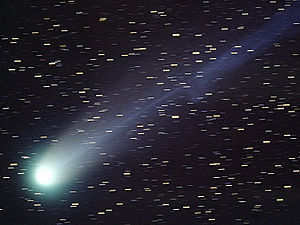
In 16 years of data observations, the Solar Heliophysics Observatory (SOHO) — a joint European Space Agency and NASA mission — – made an unexpected claim for fame: the sighting of new comets at an alarming rate. SOHO has spotted over 2100 comets, most of which are from what’s known as the Kreutz family, which graze the solar atmosphere where they usually evaporate completely.
But on December 2, 2011, the discovery of a new Kreutz-family comet was announced. This comet was found the old-fashioned way: from the ground.
Australian astronomer Terry Lovejoy spotted the comet, making this the first time a Kreutz comet has been found through a ground-based telescope since the 1970’s. The comet has been designated C/2011 W3 (Lovejoy).
Discovering a comet before it moves into view of space-based telescopes, gives scientists the opportunity to prepare the telescopes for the best possible observations. Indeed, since comet Lovejoy was visible from the ground, scientists have high hopes that this might be an exceptionally bright comet, making it all the easier to view and study. (Some Kreutz comets — – such as Ikeya-Seki in 1965 — are so bright they can be seen with the naked eye in the daytime, though this is extremely rare.)
The comet moved into view of the Solar Terrestrial Relations Observatory (STEREO) on Monday, December 12. It should be visible in SOHO by Wednesday, Dec 14.
Next up is Hinode, which will make observations at about 6 p.m. ET on Dec 15, as the comet moves towards its closest approach to the sun. Hinode’s solar optical telescope will take the highest resolution images of this close approach. As the comet passes through the sun’s atmosphere, the corona, an increase in particle collisions may produce X-rays, so Hinode may also capture X-ray images of the comet.
The comet will likely pass within some 87,000 miles of the sun, and disappear behind the northwest limb of the sun shortly after it is seen by Hinode.
For additional updates please watch:http://sungrazer.nrl.navy.mil/index.php?p=news/birthday_comet

